The NVIDIA GeForce GTX 1070 Ti Founders Edition Review: GP104 Comes in Threes
by Nate Oh on November 2, 2017 9:00 AM EST- Posted in
- GPUs
- GeForce
- NVIDIA
- Pascal
- GTX 1070 Ti
Overclocking
As NVIDIA is pushing the GTX 1070 Ti for overclocking, it is only fair that we look into it. While NVIDIA does support overclocking, they have limited actual overvolting, and instead providing the ability to unlock 1-2 more boost bins and associated voltages. Using Precision XOC, we adjusted the core and memory clocks, as well as the power/temperature limit and percent 'overvoltage.' For the 180W GTX 1070 Ti, the TDP and TDP limit match the GTX 1080, resulting in a 120% power limit (216W). The 1.093v boost voltage is no surprise, matching the GTX 1080 and 1070 FEs.
| GTX 1070 Ti FE Overclocking | ||||
| Stock | Overclocked | |||
| Core Clock | 1607MHz | 1787MHz | ||
| Boost Clock | 1683MHz | 1863MHz | ||
| Max Boost Clock | 1898MHz | 2078MHz | ||
| Memory Clock | 8Gbps | 8.8Gbps | ||
| Max Voltage | 1.062v | 1.093v | ||
The results, of course, cannot be taken as representative of all GTX 1070 Ti Founders Editions, as this is only a sampled sample size of one. But results here can offer some insight. For one, if there were explicit actual overvolting, it seems very possible to stabilize ~2100+MHz clocks on the GTX 1070 Ti Founders Edition. At any rate, GPU overclocks topped out with observed clocks in the high 2000MHz region, roughly 10% over the previously measured average in-game clockspeeds. Memory overclocks were only able to go up 200MHz from the base 2002MHz, or also about 10%. All-in-all, very similar to the GTX 1070 FE, which also managed 10% overclocks on both GPU and GDDR5 memory. Recalling that the GTX 1070 Ti FE clocked on average just 2% higher than the GTX 1070 FE at stock, there's nothing particularly groundbreaking here, especially considering the 20-25% overclock capability of Maxwell 2 reference cards.
A total of four different overclocks were tested. First was a baseline, consisting of 100% overvoltage and max power/temperature limits. The second was overclocking the GDDR5 memory by 800Mbps. The third was overclocking the GPU with a +180MHz offset; in practice this resulted in observed clocks between 2030 - 2080MHz. Lastly, all previous adjustments were combined for an overall overclock.
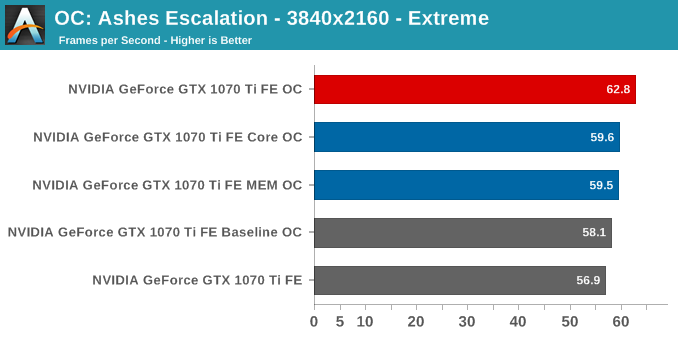
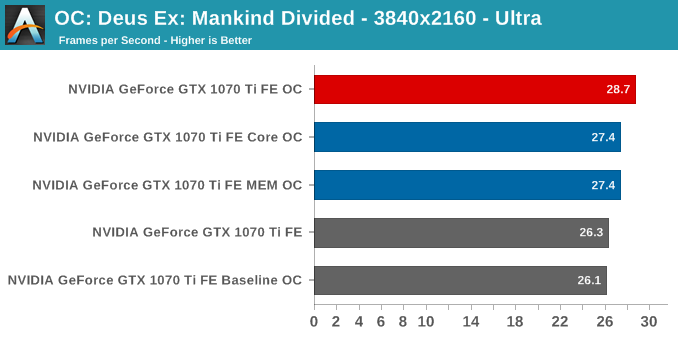
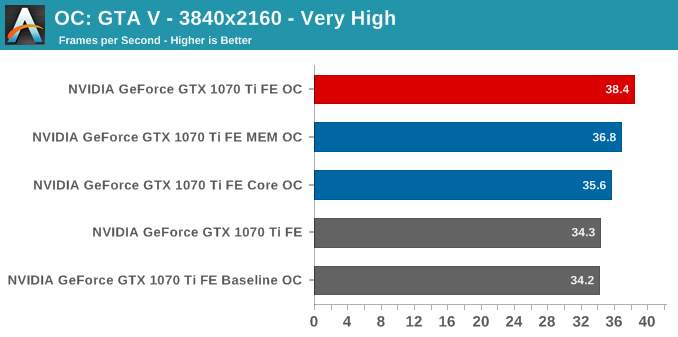
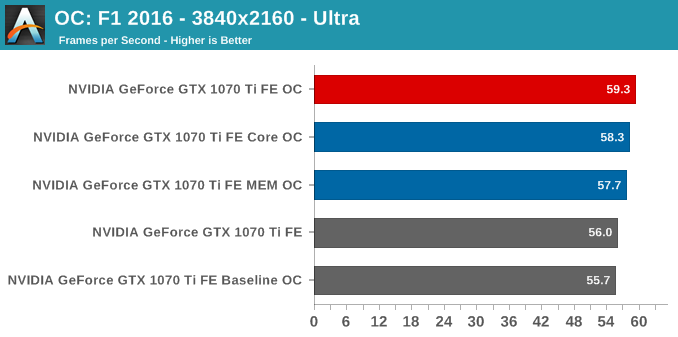
Although this is more of a cursory look than anything else, the combined overclock provides the best performance, just like it was for the GTX 1080 and 1070, although it seems like memory overclocking is more effective on the GTX 1070 Ti. Earlier, we mentioned how the GTX 1070 Ti compared to the GTX 1070 by having four more SMs but without any additional memory bandwidth, and perhaps that is playing a role here.
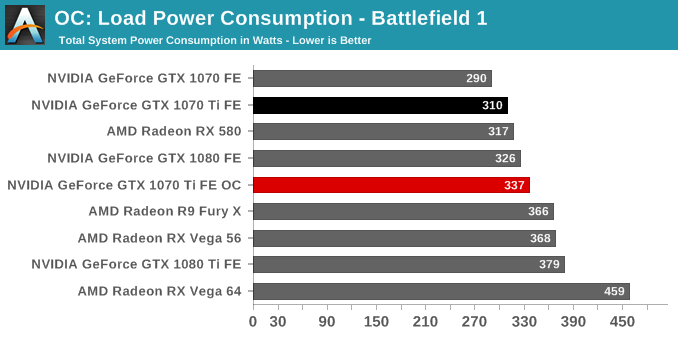
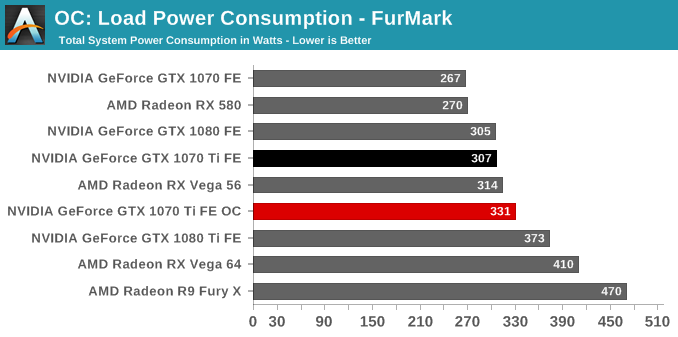
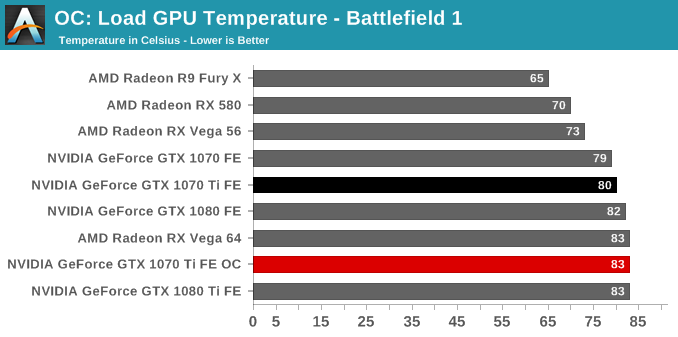
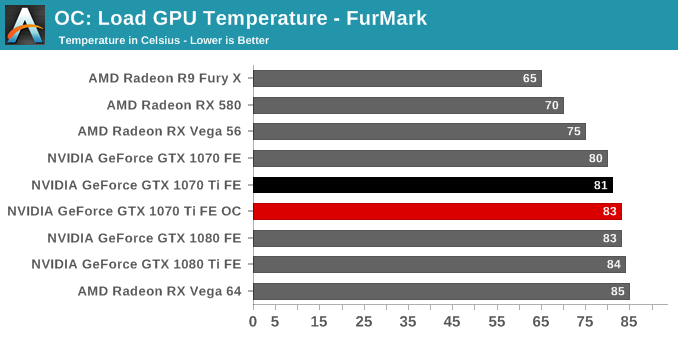
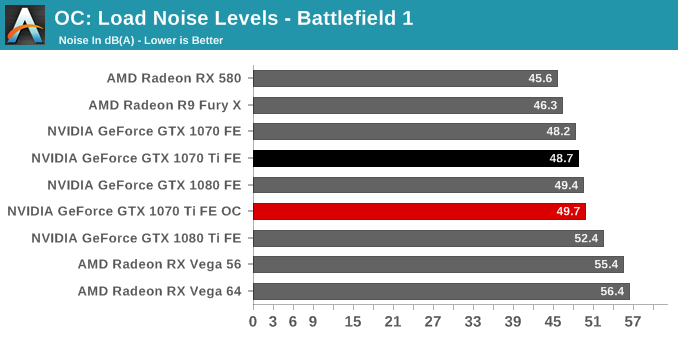
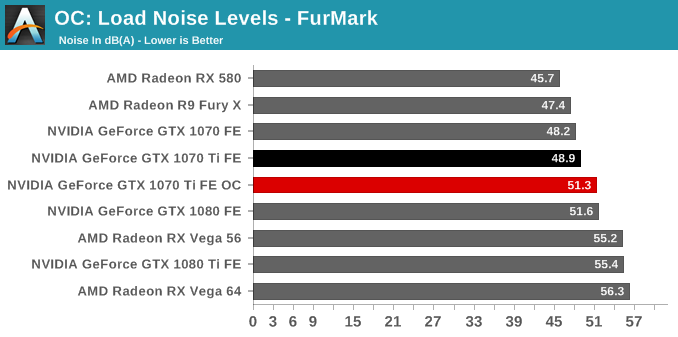
There isn't much to add on the power, temperature, and noise front. Understandably, the card will heat up a few more degrees and spin its blower faster, at the expense of ~25W at the wall, inasmuch as the 120% power limit will let it. As a casual overclocker, there may not be a lot to gain here; the GTX 1070 Ti FE already boosts to ~1800+MHz at stock, and squeezing 200MHz more with the anemic capabilities of NVIDIA's reference PCB won't make waves. And for hardcore overclockers, there would be little need of the reference board's power delivery system.










78 Comments
View All Comments
Morawka - Thursday, November 2, 2017 - link
Nvidia has a ton of flawless GP104 dies stockpiled and the 1080's are selling because they use GDDR5X memory which is slower for mining. This makes perfect sense if what i describe is true. You get rid of all those extra GP104 dies by paring it with lower latency GDDR5. This card was built with miners in mind, particularly with the GDDR5 implementation. .Morawka - Thursday, November 2, 2017 - link
**Miners are not buying gtx 1080 due to slower GDDR5X. Nvidia re-engineers 1080 for better mining performance.CiccioB - Friday, November 3, 2017 - link
Your logic is somehow faulty.The chip mounted on this 1070Ti is far for allowing them to recycle any stockpile of defective chips: it requires the chip to be fully functional but a single SM (5% of the chip).
nvidia could sell much more faulty chips with the original 1070 card at whatever price seen the miners do ask for them as if they were slices of bread.
What nvidia is doing here is just creating a card that on benchmarks runs better than the concurrent card using slightly faulty chips (or disabling them on purpose), selling the card at higher price than the 1070 and just a little below the 1080.
If nvidia had lots of defective GP104 to get rid they could just have created a 1060Ti. But that would be a useless card that would compete with none but 1070, that is they would lose money by doing do.
Kevin G - Thursday, November 2, 2017 - link
AMD has had a long road to get everything integrated together but things finally seem to be falling into place with a common on-die fabric. Their previous SoC designs still had a proprietary bus for the on-die GPU. Infinity fabric is also being pushed to the GPU team for scaling up their designs as well. Long term, I would predict some GPUs falling into the same sockets as their processors for HPC workloads. This long term idea probably won't happen until they use multiple GPU dies on a single interposer.AMD had to do all this work while the company was in in the red but it looks like the results are paying off with a competitive CPU architecture again and some gains on the GPU side too. They're back in the black but I don't think AMD can afford to allocate the resources to a pure enterprise compute project. They won't ignore that market, but the base architecture will stem from the gaming side.
cwolf78 - Thursday, November 2, 2017 - link
I agree it's too expensive as well. I think this should have been set at $399. The sad part is that it's going to be impossible to find at even the MSRP in short order. I'm content to stick with my overclocked GTX 970 until this mining fad is over - or until the current crypto formats become resistant to GPU-based mining.extide - Thursday, November 2, 2017 - link
Honestly, I see nvidia phasing out the vanilla 1070 over the next few months and then sliding the 1070 Ti into the $399 price slot.CiccioB - Thursday, November 2, 2017 - link
This means nvidia is not going to sell GP104 with more than a single SM broken... which is a great waste of money for them. So no, they will keep the old card in stock and this Ti version, in fact, will be rarely found, as it is created just for looking better on charts against a no available card from the concurrent. So it does not need to be produced in mass (and probably cutting that single SM on purpose on a perfectly good die, as I do not think that the availability of GP104 with 1 bad SM can be higher that with 5 bad SM).zepi - Thursday, November 2, 2017 - link
Such chips could still be used sa GTX1070M, so there is still a product where they can be used.Not to mention that at this point of the GP104 manufacturing they should be having very nice yields already.
DanNeely - Thursday, November 2, 2017 - link
There's also the Quadro P4000 which at 14 SM enabled is the lowest end GP104 part on the market.But yeah the 1070 TI only having a single disabled SM almost certainly speaks to much higher yields since the product first launched a year and a half ago.
znd125 - Thursday, November 2, 2017 - link
Great writing and review.